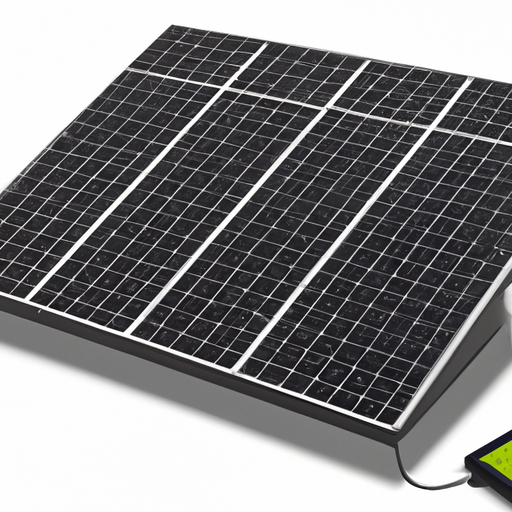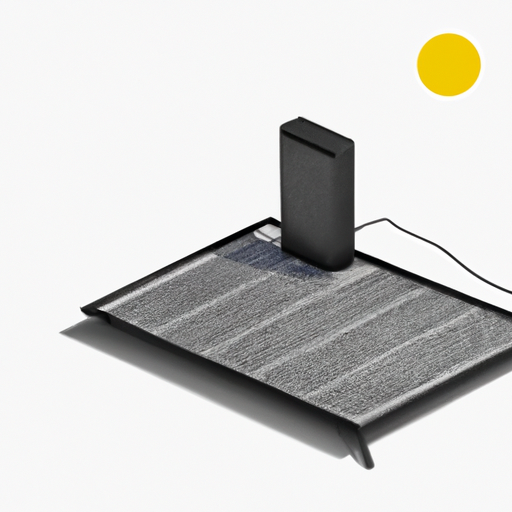

So you’ve invested in a portable solar generator, and now you want to make sure you’re getting the most out of it, right? Well, you’re in luck! I’m here to share some tips on how you can maximize the efficiency of your portable solar generator during charging.
First off, it’s important to position your solar panels properly. Make sure they are angled directly towards the sun and are not obstructed by any trees or buildings. This will ensure that they receive maximum sunlight, which translates to more energy being generated and ultimately a faster charging time.
Additionally, try to charge your portable solar generator during the sunniest part of the day. This is when the sun is at its strongest, and your panels will be able to soak up the most sunlight. Of course, this might not always be possible depending on your schedule, but it’s worth considering if you want to charge your generator as efficiently as possible.
These are just a couple of tips to get you started, but there’s so much more to learn about maximizing the efficiency of a portable solar generator during charging. If you want to delve deeper into this topic, be sure to check out the rest of the article where we’ll share even more valuable tips and tricks to help you get the most out of your investment. Portable solar generators are a popular choice among outdoor enthusiasts, campers, and those who want an alternative power source during emergencies. These compact and environmentally-friendly devices generate electricity from the sun, providing you with a convenient and sustainable energy solution. However, to ensure that your portable solar generator operates at its best, there are several factors that you need to consider.


Solar Panel Angle
The angle at which your solar panel is positioned plays a crucial role in maximizing its efficiency. To determine the ideal angle, you need to consider your location and the tilt of the sun. In general, it is recommended to set the solar panel at an angle equal to your latitude, with slight adjustments based on the time of year. By aligning the solar panel correctly, you allow it to capture the maximum amount of sunlight and generate more power.
Throughout the day, the angle of the sun changes, so it’s essential to adjust the solar panel accordingly. This can be done manually by repositioning the panel every few hours or by using adjustable mounts or trackers. These tools automatically tilt the panel to follow the sun’s path, ensuring maximum exposure and efficiency.
Sun Exposure
While the solar panel angle is crucial, it’s equally important to ensure unobstructed sun exposure. You want to position your portable solar generator in an area with the least amount of shade or obstruction. Even a small amount of shade can significantly reduce the power output of your solar panel.
Before setting up your solar generator, be mindful of any trees, buildings, or other objects that may cast shadows on the panel throughout the day. If possible, choose an open area with ample sunlight and minimal shading. This will help optimize the performance of your solar generator.


Temperature
Temperature can also affect the efficiency of your portable solar generator. Solar panels work best in cooler temperatures, typically around 25 degrees Celsius (77 degrees Fahrenheit). As temperatures rise, the output of the panels may decrease due to increased resistance within the system.
To avoid overheating, it is essential to provide proper ventilation for your solar generator. Ensure that the panel has sufficient airflow around it, especially during hot summer days. You can also use fans or other cooling mechanisms to maintain the temperature within an optimal range. By managing the temperature, you can prevent efficiency loss and prolong the lifespan of your solar generator.
Battery Capacity
The capacity of your portable solar generator’s battery determines how much energy it can store and how long it will last during use. To choose the right battery capacity, you need to assess your power needs. Consider the devices you plan to charge or power with the generator and estimate their energy consumption.
It’s always better to select a battery with a slightly higher capacity than your estimated power needs. This ensures that you have enough energy stored to sustain you during periods of low sunlight or high power consumption. If you find that your current battery capacity is insufficient, consider upgrading to a higher-capacity battery to maximize the efficiency and usability of your solar generator.
Cable Quality
The quality of the cables used in your solar generator setup can significantly impact its efficiency. High-quality cables with low resistance allow for better transmission of power from the solar panel to the battery. On the other hand, poor-quality cables or those with damage can lead to power loss and reduced efficiency.
When choosing cables for your solar generator, opt for ones that are specifically designed for solar applications. These cables are built to withstand outdoor conditions and have better conductivity. Additionally, regularly inspect your cables for any signs of wear or damage and replace them as needed. By ensuring proper cable quality and connection, you can maximize the efficiency of your portable solar generator.
Utilizing Efficient Charge Controllers
Charge controllers play a crucial role in regulating the charging process of your solar generator. They help prevent overcharging and ensure that the battery receives the optimal amount of power. When selecting a charge controller, consider ones that provide voltage regulation and maximum power point tracking (MPPT).
Voltage regulation ensures that the battery receives a steady and appropriate amount of charge, preventing damage from overcharging. MPPT charge controllers, on the other hand, maximize the power output of the solar panel by finding the optimal operating point. This enables more efficient power conversion and ultimately increases the charging efficiency of your portable solar generator.
Maintaining and Cleaning Solar Panels
Regular maintenance and cleaning of your solar panels are essential to ensure maximum efficiency. Over time, dust, debris, and other particles can accumulate on the surface of the panels, reducing their ability to absorb sunlight. This build-up can significantly impact the charging performance of your portable solar generator.
Regularly inspect your solar panels for any signs of dirt or obstruction. If needed, use a soft brush or cloth to gently clean the surface. Avoid using abrasive materials or harsh chemicals that can scratch or damage the panels. By keeping your solar panels clean and free from obstructions, you can prevent efficiency loss and maintain optimal charging performance.
Monitoring and Optimizing Charging Performance
To further maximize the efficiency of your portable solar generator, consider using monitoring devices to track its charging performance. These devices provide real-time data on the solar panel’s output, battery voltage, and charging status. By analyzing this data, you can determine if any adjustments need to be made to optimize the charging process.
For example, if you notice that the battery voltage is consistently low, you may need to adjust the solar panel angle or increase the battery capacity. Monitoring devices help you make informed decisions and ensure that your solar generator is operating at its best.
In conclusion, maximizing the efficiency of a portable solar generator during charging involves considering various factors such as solar panel angle, sun exposure, temperature management, battery capacity, cable quality, charge controller selection, maintenance, and monitoring. By following best practices and implementing the tips discussed in this article, you can optimize the performance and functionality of your portable solar generator. Remember, a small investment in maximizing efficiency can lead to significant benefits in terms of power output and long-term sustainability.



